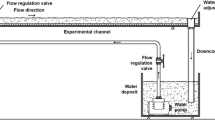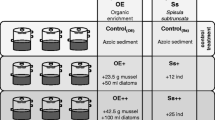Abstract
In order to understand the effect of changing nutrient conditions on benthic microalgae on hard substrates, in-situ experiments with artificial substrates were conducted in Kiel Fjord, Western Baltic Sea. As an extension of previous investigations, we used artificial substrates without silicate and thus were able to supply nutrient media with different Si:N ratios to porous substrates, from where they trickled out continuously. The biofilm developing on these substrates showed a significant increase in biovolume due to N + P enrichment, while Si alone had only minor effects. The stoichiometric composition of the biomass indicated nitrogen limitation during most of the year. The C:N ratios were lowered by the N + P addition. The algae were dominated by diatoms in most cases, but rhodophytes and chlorophytes also became important. The nutrient treatment affected the taxonomic composition mostly at the species level. The significance of the results with regard to coastal eutrophication is discussed.
Similar content being viewed by others
References
Admiraal, W., 1984. The ecology of estuarine sediment-inhabiting diatoms. Progr. Phycol. Res. 3: 269–322.
Bidle, K. D. & F. Azam, 1999. Accelerated dissolution of diatom silica by marine bacterial assemblages. Nature 397: 508–512.
Bodeanu, N., 1993. Microalgal blooms in the Romanian area of the Black Sea and contemporary eutrophication conditions. In Smayda, T. J. & Y. Shimizu (eds), Toxic Phytoplankton Blooms in the Sea. Elsevier Science Publ., Amsterdam: 203–209.
Borchardt, M. A., 1996. Nutrients. In Stevenson, R. J., M. L. Bothwell & R. L. Lowe (eds), Algal Ecology-Freshwater Benthic Ecosystems. Academic Press, London: 183–227.
Bothwell, M. L., 1985. Phosphorus limitation of lotic periphyton groth rates: an intersite comparison using continuous flow throughs (Thompson River, British Columbia). Limnol. Oceanogr. 30: 527–542.
Bothwell, M. L., 1989. Phosphorus-limited growth dynamics of lotic periphyton diatom communities: Areal biomass and cellular growth rate response. Can. J. Fish. Aquat. Sci. 46: 1293–1301.
Carrick, H. J., R. L. Lowe & J. T. Rotenberry, 1988. Guilds of benthic algae along nutrient gradients: relationships to algal community diversity. J. n. am. Benthol. Soc. 7: 117–128.
Carrick, H. J. & R. L. Lowe, 1988. Response of Lake Michigan benthic algae to in situ enrichment with Si, N and P. Can. J. Fish. aquat. Sci. 45: 271–279.
Conley, D. J., C. L. Schelske & E. F. Stoermer, 1993. Modification of the biogeochemical cycle of silica with eutrophication. Mar. Ecol. Prog. Ser. 101: 179–192.
D'Elia, C. F., J. G. Sanders & W. R. Boynton, 1986. Nutrient enrichment studies in a coastal plain estuary: phytoplankton growth in large scale, continuous cultures. Can. J. Fish. aquat. Sci. 43: 397–406.
Daniel, G. F., A. H. L. Chamberlain & E. B. G. Jones, 1987. Cytochemical and electron microscopical observations on the adhesive materials of marine fouling diatoms. Br. Phycol. J. 22: 101–118.
Deegen, P., 1997. Nährstoffansprüche von Aufwuchsalgen der Kieler Förde. Msc thesis. Christian-Albrechts-Universität zu Kiel: 90 pp.
Flothmann, S. & I. Werner, 1992. Experimental eutrophication on an intertidal sandflat: effects on microphytobenthos, meio-and macrofauna. In Colombo, G., I. Ferrari, V. U. Ceccherelli & R. Rossi (eds), Marine Eutrophication and Population dynamics. Proceed. 25th Europ. Mar. Biol. Symp. Olsen & Olsen, Fredenborg: 93–100.
Hepinstall, J. A. & R. L. Fuller, 1994. Periphyton reactions to different light and nutrient levels and the response of bacteria to these manipulations. Arch. Hydrobiol. 131: 161–173.
Hecky, R. E., P. Campbell & L. L. Hendzel, 1993. The stoichiometry of carbon, nitrogen and phosphorus in particulate matter of lakes and oceans. Limnol. Oceanogr. 38: 709–724.
Hillebrand, H. & U. Sommer, 1997. Response of epilithic microphytobenthos of the western Baltic Sea to in situ experiments with nutrient enrichment. Mar. Ecol. Prog. Ser. 160: 35–46.
Hillebrand, H. & U. Sommer, 1999. The nutrient stoichiometry of benthic microagal growth: redfield proportions are optimal. Limnol. Oceanogr. 44: 440–446.
Hillebrand, H., C. D. Dürselen, D. Kirschtel, U. Pollingher & T. Zohary, 1999. Biovolume calculation for pelagic and benthic microalgae. J. Phycol. 35: 403–424.
Hoagland, K. D., S. C. Roemer & J. R. Rosowski, 1982. Colonization and community structure of twoperiphyton assemblages, with emphasis on the diatoms (Bacillariophyceae). Am. J. Bot. 69: 188–213.
Hudon, C. & E. Bourget, 1981. Initial colonization of artificial substrate: community development and structure studied by Scanning Electron Microscopy. Can. J. Fish. aquat. Sci. 38: 1371–1384.
Kahlert, M., 1998. C:N:P ratios of freshwater benthic algae. Arch. Hydrobiol. Spec. Issue. Adv. Limnol. 51: 105–118.
Lotze, H. K., 1998. Population dynamics and species interactions in macroalgal blooms: abiotic versus biotic control at different lifecycle stages. Ph. D. thesis Christian-Albrechts-Universität Kiel: 134 pp.
Malone, T. C., D. J. Conley, T. R. Fisher, P. M. Glibert, L. W. Harding & K. G. Sellner, 1996. Scales of nutrient-limited phytoplankton productivity in Chesapeake Bay. Estuaries 19: 371–385.
McCormick, P. V., 1996. Resource competition and species coexistence in freshwater algal assemblages. In Stevenson, R. J., M. L. Bothwell & R. L. Lowe (eds), Algal Ecology-Freshwater Benthic Ecosystems. Academic Press, London: 229–252.
Nilsson, C., 1995. Microbenthic communities with emphasis on algal-nutrient relations. Ph. D. thesis, Göteborg University: 109 pp.
Nilsson, P., B. Jönsson, I. Lindström Swanberg & K. Sundbäck, 1991. Response of a marine shallow-water sediment system to an increased load of inorganic nutrients. Mar. Ecol. Prog. Ser. 71: 275–290.
Parker, B. C., 1969. Occurrence of silica in brown and green algae. Can. J. Bot. 47: 537–540.
Pedersen, M. F. & J. Borum, 1997. Nutrient control of estuarine macroalgae: growth strategy and the balance between nitrogen requirements and uptake. Mar. Ecol. Prog. Ser. 161: 155–163.
Rahm, L., D. J. Conley, P. Sanden, F. Wulff & P. Stålnacke, 1996. Time series analysis of nutrient inputs to the Baltic Sea and changing Dsi: DIN ratios. Mar. Ecol. Prog. Ser. 130: 221–228.
Riber, H. H. & R. G. Wetzel, 1987. Boundary-layer and internal diffusion effects on phosphorus fluxes in lake periphyton. Limnol. Oceanogr. 32: 1181–1194.
Riegman, R., A. A. M. Noordeloos & Cadée, G. C., 1992. Phaeocystis blooms and eutrophication of the continental coastal zones of the North Sea. Mar. Biol. 112: 479–484.
Sabater, S., S. V. Gregory & J. R. Sedell, 1998. Community dynamics and metabolism of benthic algae colonizing wood and rock substrata in a forest stream. J. Phycol. 34: 561–567.
Sigmon, D. E. & L. B. Cahoon, 1997. Comparative effects of benthic microalgae and phytoplankton on dissolved silica fluxes. Aquat. Microb. Ecol. 13: 275–284.
Snoeijs, P., 1991. Monitoring pollution effects by diatom community composition. A comparison of sampling methods. Arch. Hydrobiol. 121: 497–510.
Sommer, U., 1994. Are marine diatoms favoured by high Si:N ratios? Mar. Ecol. Prog. Ser. 115: 309–315.
Sommer, U., 1996. Nutrient competition experiments with periphyton from the Baltic Sea. Mar. Ecol. Prog. Ser. 140: 161–167.
Sundbäck, K. & P. Snoeijs, 1991. Effects of nutrient enrichment on microalgal community composition in a coastal shallow-water sediment system: an experimental study. Bot. Mar. 34: 341–358.
Wetzel, R. G., 1996. Benthic algae and nutrient cycling in lentic freshwater ecosystems. In Stevenson, R. J., M. L. Bothwell & R. L. Lowe (eds), Algal Ecology-Freshwater Benthic Ecosystems. Academic Press, London: 641–667.
Author information
Authors and Affiliations
Corresponding author
Rights and permissions
About this article
Cite this article
Hillebrand, H., Sommer, U. Effect of continuous nutrient enrichment on microalgae colonizing hard substrates. Hydrobiologia 426, 185–192 (2000). https://doi.org/10.1023/A:1003943201178
Issue Date:
DOI: https://doi.org/10.1023/A:1003943201178




